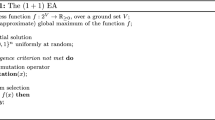Abstract
A core feature of evolutionary algorithms is their mutation operator. Recently, much attention has been devoted to the study of mutation operators with dynamic and non-uniform mutation rates. Following up on this line of work, we propose a new mutation operator and analyze its performance on the (1+1) Evolutionary Algorithm (EA). Our analyses show that this mutation operator competes with pre-existing ones, when used by the (1+1) EA on classes of problems for which results on the other mutation operators are available. We present a “jump” function for which the performance of the (1+1) EA using any static uniform mutation and any restart strategy can be worse than the performance of the (1+1) EA using our mutation operator with no restarts. We show that the (1+1) EA using our mutation operator finds a (1/3)-approximation ratio on any non-negative submodular function in polynomial time. This performance matches that of combinatorial local search algorithms specifically designed to solve this problem.
Finally, we evaluate experimentally the performance of the (1+1) EA using our operator, on real-world graphs of different origins with up to \(\sim \)37 000 vertices and \(\sim \)1.6 million edges. In comparison with uniform mutation and a recently proposed dynamic scheme our operator comes out on top on these instances.
A full version of this paper is available at http://arxiv.org/abs/1805.10902.
Access this chapter
Tax calculation will be finalised at checkout
Purchases are for personal use only
Similar content being viewed by others
Notes
- 1.
Source categories of the 67 instances: 2x bio-*, 6x ca-*, 5x ia-*, 2x inf-*, 1x soc-*, 40x socfb-*, 4x tech-*, 7x web-*. The largest graph is socfb-Texas84 with 36 364 vertices and 1 590 651 edges.
References
Ageev, A.A., Sviridenko, M.: An 0.828-approximation algorithm for the uncapacitated facility location problem. Discrete Appl. Math. 93(2–3), 149–156 (1999)
Doerr, B., Jansen, T., Sudholt, D., Winzen, C., Zarges, C.: Mutation rate matters even when optimizing monotonic functions. Evol. Comput. 21(1), 1–27 (2013)
Doerr, B., Le, H.P., Makhmara, R., Nguyen, T.D.: Fast genetic algorithms. In: GECCO, pp. 777–784 (2017)
Droste, S., Jansen, T., Wegener, I.: On the analysis of the (1+1) evolutionary algorithm. Theoret. Comput. Sci. 276(1–2), 51–81 (2002)
Eiben, A.E., Hinterding, R., Michalewicz, Z.: Parameter control in evolutionary algorithms. IEEE Trans. Evol. Comput. 3(2), 124–141 (1999)
Eiben, A.E., Smith, J.E.: Introduction to Evolutionary Computation. Natural Computing Series. Springer, Heidelberg (2003). https://doi.org/10.1007/978-3-662-05094-1
Feige, U., Mirrokni, V.S., Vondrák, J.: Maximizing non-monotone submodular functions. SIAM J. Comput. 40(4), 1133–1153 (2011)
Friedrich, T., He, J., Hebbinghaus, N., Neumann, F., Witt, C.: Approximating covering problems by randomized search heuristics using multi-objective models. Evol. Comput. 18(4), 617–633 (2010)
Friedrich, T., Neumann, F.: Maximizing submodular functions under matroid constraints by evolutionary algorithms. Evol. Comput. 23(4), 543–558 (2015)
Friedrich, T., Quinzan, F., Wagner, M.: Esca** large deceptive basins of attraction with heavy mutation operators. In: GECCO (2018, accepted). https://hpi.de/friedrich/docs/paper/GECCO18.pdf
Goemans, M.X., Williamson, D.P.: Improved approximation algorithms for maximum cut and satisfiability problems using semidefinite programming. J. ACM 42(6), 1115–1145 (1995)
Håstad, J.: Some optimal inapproximability results. J. ACM 48(4), 798–859 (2001)
Jansen, T., Wegener, I.: Real royal road functions-where crossover provably is essential. Discrete Appl. Math. 149(1–3), 111–125 (2005)
Krause, A., Guestrin, C.: Near-optimal observation selection using submodular functions. In: AAAI, pp. 1650–1654 (2007)
Lee, J., Mirrokni, V.S., Nagarajan, V., Sviridenko, M.: Non-monotone submodular maximization under matroid and knapsack constraints. In: STOC, pp. 323–332 (2009)
Lehmann, B., Lehmann, D.J., Nisan, N.: Combinatorial auctions with decreasing marginal utilities. Games Econ. Behav. 55(2), 270–296 (2006)
Mühlenbein, H.: How genetic algorithms really work: mutation and hillclimbing. In: PPSN, pp. 15–26 (1992)
Rossi, R.A., Ahmed, N.K.: The Network Data Repository with Interactive Graph Analytics and Visualization (Website) (2015). http://networkrepository.com
Wagner, M., Friedrich, T., Lindauer, M.: Improving local search in a minimum vertex cover solver for classes of networks. In: CEC, pp. 1704–1711 (2017)
Wegener, I.: Theoretical aspects of evolutionary algorithms. In: Orejas, F., Spirakis, P.G., van Leeuwen, J. (eds.) ICALP 2001. LNCS, vol. 2076, pp. 64–78. Springer, Heidelberg (2001). https://doi.org/10.1007/3-540-48224-5_6
Witt, C.: Worst-case and average-case approximations by simple randomized search heuristics. In: Diekert, V., Durand, B. (eds.) STACS 2005. LNCS, vol. 3404, pp. 44–56. Springer, Heidelberg (2005). https://doi.org/10.1007/978-3-540-31856-9_4
Acknowledgements
The authors would like to thank Martin Krejca for giving his advice on one of the proofs, and Karen Seidel for proof-reading the paper.
Author information
Authors and Affiliations
Corresponding author
Editor information
Editors and Affiliations
Rights and permissions
Copyright information
© 2018 Springer Nature Switzerland AG
About this paper
Cite this paper
Friedrich, T., Göbel, A., Quinzan, F., Wagner, M. (2018). Heavy-Tailed Mutation Operators in Single-Objective Combinatorial Optimization. In: Auger, A., Fonseca, C., Lourenço, N., Machado, P., Paquete, L., Whitley, D. (eds) Parallel Problem Solving from Nature – PPSN XV. PPSN 2018. Lecture Notes in Computer Science(), vol 11101. Springer, Cham. https://doi.org/10.1007/978-3-319-99253-2_11
Download citation
DOI: https://doi.org/10.1007/978-3-319-99253-2_11
Published:
Publisher Name: Springer, Cham
Print ISBN: 978-3-319-99252-5
Online ISBN: 978-3-319-99253-2
eBook Packages: Computer ScienceComputer Science (R0)




